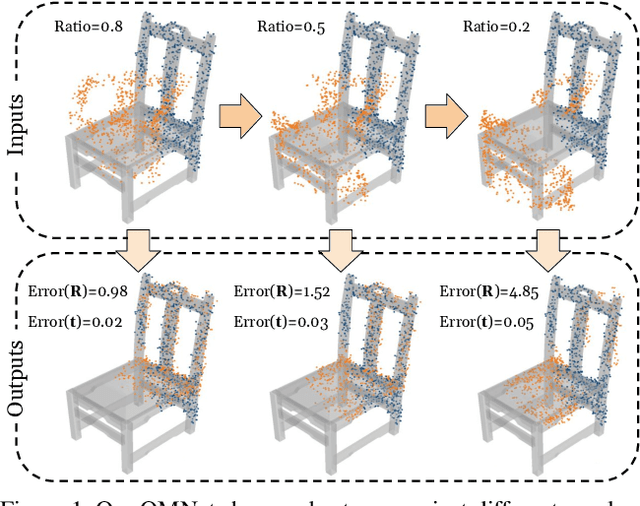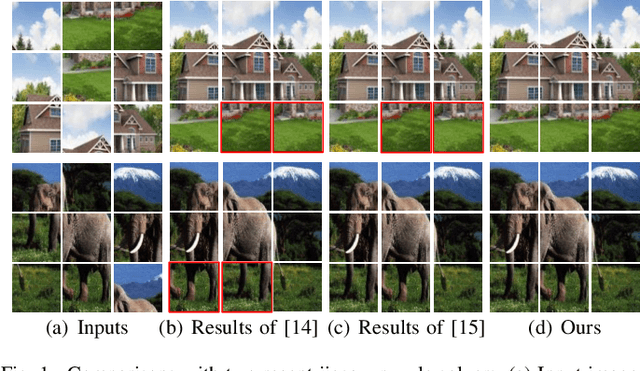Guanghui Liu
FlowPolicy: Enabling Fast and Robust 3D Flow-based Policy via Consistency Flow Matching for Robot Manipulation
Dec 06, 2024Abstract:Robots can acquire complex manipulation skills by learning policies from expert demonstrations, which is often known as vision-based imitation learning. Generating policies based on diffusion and flow matching models has been shown to be effective, particularly in robotics manipulation tasks. However, recursion-based approaches are often inference inefficient in working from noise distributions to policy distributions, posing a challenging trade-off between efficiency and quality. This motivates us to propose FlowPolicy, a novel framework for fast policy generation based on consistency flow matching and 3D vision. Our approach refines the flow dynamics by normalizing the self-consistency of the velocity field, enabling the model to derive task execution policies in a single inference step. Specifically, FlowPolicy conditions on the observed 3D point cloud, where consistency flow matching directly defines straight-line flows from different time states to the same action space, while simultaneously constraining their velocity values, that is, we approximate the trajectories from noise to robot actions by normalizing the self-consistency of the velocity field within the action space, thus improving the inference efficiency. We validate the effectiveness of FlowPolicy on Adroit and Metaworld, demonstrating a 7$\times$ increase in inference speed while maintaining competitive average success rates compared to state-of-the-art policy models. Codes will be made publicly available.
Adaptive Paradigm Synergy: Can a Cross-Paradigm Objective Enhance Long-Tailed Learning?
Oct 30, 2024Abstract:Self-supervised learning (SSL) has achieved impressive results across several computer vision tasks, even rivaling supervised methods. However, its performance degrades on real-world datasets with long-tailed distributions due to difficulties in capturing inherent class imbalances. Although supervised long-tailed learning offers significant insights, the absence of labels in SSL prevents direct transfer of these strategies.To bridge this gap, we introduce Adaptive Paradigm Synergy (APS), a cross-paradigm objective that seeks to unify the strengths of both paradigms. Our approach reexamines contrastive learning from a spatial structure perspective, dynamically adjusting the uniformity of latent space structure through adaptive temperature tuning. Furthermore, we draw on a re-weighting strategy from supervised learning to compensate for the shortcomings of temperature adjustment in explicit quantity perception.Extensive experiments on commonly used long-tailed datasets demonstrate that APS improves performance effectively and efficiently. Our findings reveal the potential for deeper integration between supervised and self-supervised learning, paving the way for robust models that handle real-world class imbalance.
PointRegGPT: Boosting 3D Point Cloud Registration using Generative Point-Cloud Pairs for Training
Jul 19, 2024



Abstract:Data plays a crucial role in training learning-based methods for 3D point cloud registration. However, the real-world dataset is expensive to build, while rendering-based synthetic data suffers from domain gaps. In this work, we present PointRegGPT, boosting 3D point cloud registration using generative point-cloud pairs for training. Given a single depth map, we first apply a random camera motion to re-project it into a target depth map. Converting them to point clouds gives a training pair. To enhance the data realism, we formulate a generative model as a depth inpainting diffusion to process the target depth map with the re-projected source depth map as the condition. Also, we design a depth correction module to alleviate artifacts caused by point penetration during the re-projection. To our knowledge, this is the first generative approach that explores realistic data generation for indoor point cloud registration. When equipped with our approach, several recent algorithms can improve their performance significantly and achieve SOTA consistently on two common benchmarks. The code and dataset will be released on https://github.com/Chen-Suyi/PointRegGPT.
Lumiere: A Space-Time Diffusion Model for Video Generation
Feb 05, 2024



Abstract:We introduce Lumiere -- a text-to-video diffusion model designed for synthesizing videos that portray realistic, diverse and coherent motion -- a pivotal challenge in video synthesis. To this end, we introduce a Space-Time U-Net architecture that generates the entire temporal duration of the video at once, through a single pass in the model. This is in contrast to existing video models which synthesize distant keyframes followed by temporal super-resolution -- an approach that inherently makes global temporal consistency difficult to achieve. By deploying both spatial and (importantly) temporal down- and up-sampling and leveraging a pre-trained text-to-image diffusion model, our model learns to directly generate a full-frame-rate, low-resolution video by processing it in multiple space-time scales. We demonstrate state-of-the-art text-to-video generation results, and show that our design easily facilitates a wide range of content creation tasks and video editing applications, including image-to-video, video inpainting, and stylized generation.
SpectralNeRF: Physically Based Spectral Rendering with Neural Radiance Field
Dec 14, 2023



Abstract:In this paper, we propose SpectralNeRF, an end-to-end Neural Radiance Field (NeRF)-based architecture for high-quality physically based rendering from a novel spectral perspective. We modify the classical spectral rendering into two main steps, 1) the generation of a series of spectrum maps spanning different wavelengths, 2) the combination of these spectrum maps for the RGB output. Our SpectralNeRF follows these two steps through the proposed multi-layer perceptron (MLP)-based architecture (SpectralMLP) and Spectrum Attention UNet (SAUNet). Given the ray origin and the ray direction, the SpectralMLP constructs the spectral radiance field to obtain spectrum maps of novel views, which are then sent to the SAUNet to produce RGB images of white-light illumination. Applying NeRF to build up the spectral rendering is a more physically-based way from the perspective of ray-tracing. Further, the spectral radiance fields decompose difficult scenes and improve the performance of NeRF-based methods. Comprehensive experimental results demonstrate the proposed SpectralNeRF is superior to recent NeRF-based methods when synthesizing new views on synthetic and real datasets. The codes and datasets are available at https://github.com/liru0126/SpectralNeRF.
Exposure Fusion for Hand-held Camera Inputs with Optical Flow and PatchMatch
Apr 10, 2023Abstract:This paper proposes a hybrid synthesis method for multi-exposure image fusion taken by hand-held cameras. Motions either due to the shaky camera or caused by dynamic scenes should be compensated before any content fusion. Any misalignment can easily cause blurring/ghosting artifacts in the fused result. Our hybrid method can deal with such motions and maintain the exposure information of each input effectively. In particular, the proposed method first applies optical flow for a coarse registration, which performs well with complex non-rigid motion but produces deformations at regions with missing correspondences. The absence of correspondences is due to the occlusions of scene parallax or the moving contents. To correct such error registration, we segment images into superpixels and identify problematic alignments based on each superpixel, which is further aligned by PatchMatch. The method combines the efficiency of optical flow and the accuracy of PatchMatch. After PatchMatch correction, we obtain a fully aligned image stack that facilitates a high-quality fusion that is free from blurring/ghosting artifacts. We compare our method with existing fusion algorithms on various challenging examples, including the static/dynamic, the indoor/outdoor and the daytime/nighttime scenes. Experiment results demonstrate the effectiveness and robustness of our method.
FINet: Dual Branches Feature Interaction for Partial-to-Partial Point Cloud Registration
Jun 07, 2021



Abstract:Data association is important in the point cloud registration. In this work, we propose to solve the partial-to-partial registration from a new perspective, by introducing feature interactions between the source and the reference clouds at the feature extraction stage, such that the registration can be realized without the explicit mask estimation or attentions for the overlapping detection as adopted previously. Specifically, we present FINet, a feature interaction-based structure with the capability to enable and strengthen the information associating between the inputs at multiple stages. To achieve this, we first split the features into two components, one for the rotation and one for the translation, based on the fact that they belong to different solution spaces, yielding a dual branches structure. Second, we insert several interaction modules at the feature extractor for the data association. Third, we propose a transformation sensitivity loss to obtain rotation-attentive and translation-attentive features. Experiments demonstrate that our method performs higher precision and robustness compared to the state-of-the-art traditional and learning-based methods.
OMNet: Learning Overlapping Mask for Partial-to-Partial Point Cloud Registration
Mar 03, 2021



Abstract:Point cloud registration is a key task in many computational fields. Previous correspondence matching based methods require the point clouds to have distinctive geometric structures to fit a 3D rigid transformation according to point-wise sparse feature matches. However, the accuracy of transformation heavily relies on the quality of extracted features, which are prone to errors with respect partiality and noise of the inputs. In addition, they can not utilize the geometric knowledge of all regions. On the other hand, previous global feature based deep learning approaches can utilize the entire point cloud for the registration, however they ignore the negative effect of non-overlapping points when aggregating global feature from point-wise features. In this paper, we present OMNet, a global feature based iterative network for partial-to-partial point cloud registration. We learn masks in a coarse-to-fine manner to reject non-overlapping regions, which converting the partial-to-partial registration to the registration of the same shapes. Moreover, the data used in previous works are only sampled once from CAD models for each object, resulting the same point cloud for the source and the reference. We propose a more practical manner for data generation, where a CAD model is sampled twice for the source and the reference point clouds, avoiding over-fitting issues that commonly exist previously. Experimental results show that our approach achieves state-of-the-art performance compared to traditional and deep learning methods.
UPHDR-GAN: Generative Adversarial Network for High Dynamic Range Imaging with Unpaired Data
Feb 03, 2021



Abstract:The paper proposes a method to effectively fuse multi-exposure inputs and generates high-quality high dynamic range (HDR) images with unpaired datasets. Deep learning-based HDR image generation methods rely heavily on paired datasets. The ground truth provides information for the network getting HDR images without ghosting. Datasets without ground truth are hard to apply to train deep neural networks. Recently, Generative Adversarial Networks (GAN) have demonstrated their potentials of translating images from source domain X to target domain Y in the absence of paired examples. In this paper, we propose a GAN-based network for solving such problems while generating enjoyable HDR results, named UPHDR-GAN. The proposed method relaxes the constraint of paired dataset and learns the mapping from LDR domain to HDR domain. Although the pair data are missing, UPHDR-GAN can properly handle the ghosting artifacts caused by moving objects or misalignments with the help of modified GAN loss, improved discriminator network and useful initialization phase. The proposed method preserves the details of important regions and improves the total image perceptual quality. Qualitative and quantitative comparisons against other methods demonstrated the superiority of our method.
JigsawGAN: Self-supervised Learning for Solving Jigsaw Puzzles with Generative Adversarial Networks
Jan 19, 2021



Abstract:The paper proposes a solution based on Generative Adversarial Network (GAN) for solving jigsaw puzzles. The problem assumes that an image is cut into equal square pieces, and asks to recover the image according to pieces information. Conventional jigsaw solvers often determine piece relationships based on the piece boundaries, which ignore the important semantic information. In this paper, we propose JigsawGAN, a GAN-based self-supervised method for solving jigsaw puzzles with unpaired images (with no prior knowledge of the initial images). We design a multi-task pipeline that includes, (1) a classification branch to classify jigsaw permutations, and (2) a GAN branch to recover features to images with correct orders. The classification branch is constrained by the pseudo-labels generated according to the shuffled pieces. The GAN branch concentrates on the image semantic information, among which the generator produces the natural images to fool the discriminator with reassembled pieces, while the discriminator distinguishes whether a given image belongs to the synthesized or the real target manifold. These two branches are connected by a flow-based warp that is applied to warp features to correct order according to the classification results. The proposed method can solve jigsaw puzzles more efficiently by utilizing both semantic information and edge information simultaneously. Qualitative and quantitative comparisons against several leading prior methods demonstrate the superiority of our method.
 Add to Chrome
Add to Chrome Add to Firefox
Add to Firefox Add to Edge
Add to Edge